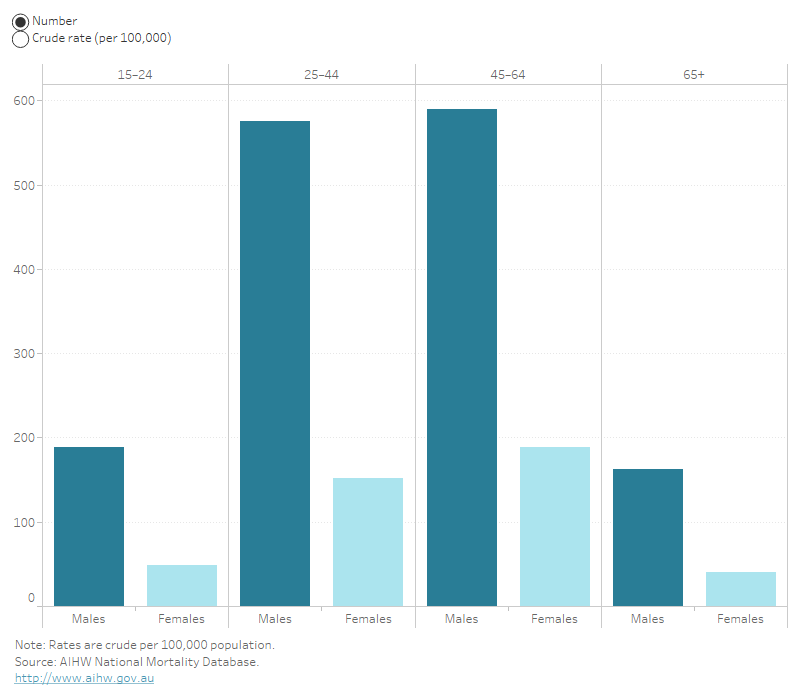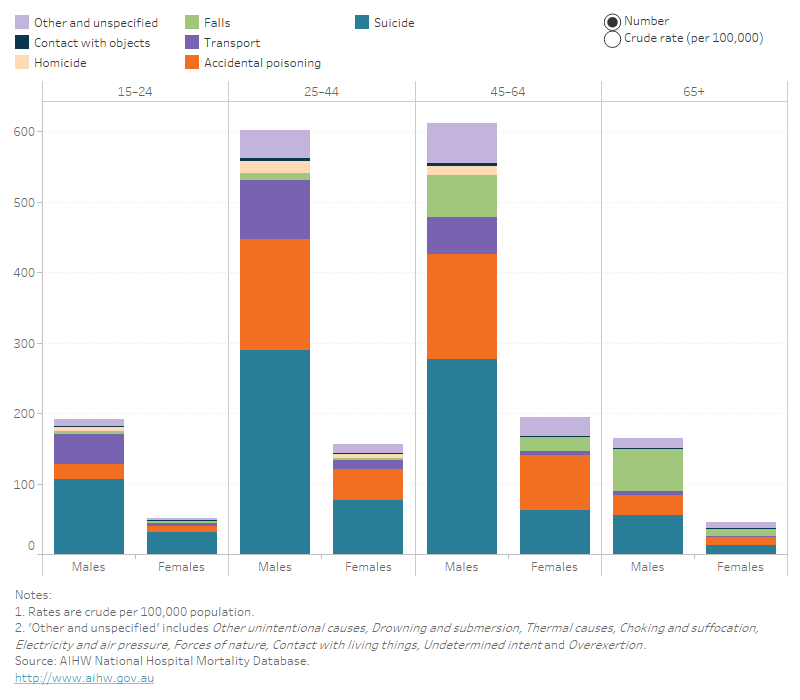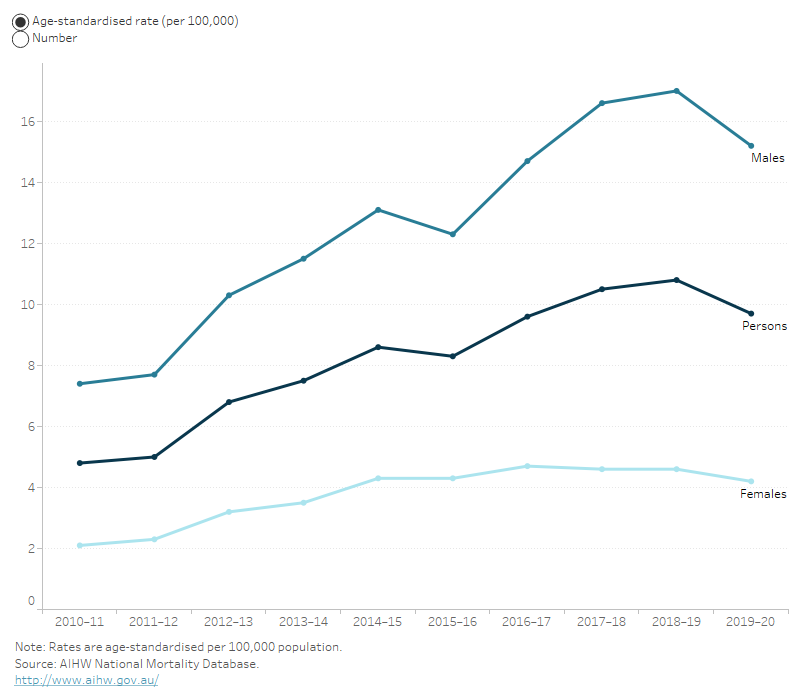Demographic variation, causes and trends from the NMD
Sex and age
In 2019–20 there were almost 1,950 alcohol-related injury deaths recorded in the AIHW National Mortality Database, 80% of which were for males, with males having an age-standardised rate 3.6 times that of females (15.2 and 4.2 per 100,000, respectively) (Table 11). While this is similar to the pattern for all injuries, where 62% of deaths were for males, the pattern is much more pronounced for alcohol-related injuries.
|
|
Males |
Females |
Persons |
|---|---|---|---|
|
Number of deaths |
1,516 |
430 |
1,946 |
|
Crude rate (per 100,000 population) |
12.1 |
3.4 |
7.7 |
|
Age standardised rate (per 100,000 population) |
15.2 |
4.2 |
9.7 |
Source: AIHW National Mortality Database.
In 2019–20, among those who died due to alcohol-related injuries (Figure 19):
- 77% of deaths occurred among those aged 25–64 years of age
- males aged 45–64 had the highest number and rate of deaths (590 deaths and 19.5 per 100,000).
There was one alcohol-related injury death among the 0–14 year age group (not shown in Figure 19).
Figure 19: Alcohol-related injury deaths, by age group and sex, 2019–20
A bar chart showing that males have higher numbers and rates of alcohol-related injury deaths than females. The highest number and rate for males and females occurs in those aged 25–64 years.

For more detailed data, see Data tables B1–3.
What were the most common causes of alcohol-related injury deaths?
The top three cause groups for alcohol-related injury deaths were suicide (47%), accidental poisoning (26%) and transport (11%) (Figure 20).
For all causes of alcohol-related injury deaths, males had higher rates than females. In 2019–20 (Figure 20):
- for suicide, males were 4.1 times as likely to die as females (7.3 per 100,000 compared to 1.8 per 100,000, respectively). This is different to the male-female pattern for alcohol-related hospitalisations, where the female rate is higher than the male rate. This may be due, at least in part, to the use of more lethal and accessible intentional self-harm mechanisms by males, such as hanging.
- for transport injuries, males were 7.5 times as likely to die as females (1.5 per 100,000 compared to 0.2 per 100,000, respectively).
In 2019–20, the most common method of:
- suicide was hanging, strangulation and suffocation (603 deaths or 66% of suicide deaths, 2.4 per 100,000)
- accidental poisoning was alcohol (266 or 53% of accidental poisoning deaths, 1.0 per 100,000).
Figure 20: Number and rate of alcohol-related injury deaths by cause, sex and age group, 2019–20
Stacked column graph showing the top causes of alcohol-related injury deaths were suicide and accidental poisoning for those aged 15–44. For males aged 65 and over, falls was the leading cause of alcohol-related injury death.

For more detailed data, see Data tables B4–12.
How have alcohol-related injury deaths changed over time?
This section compares deaths data over time and includes the first few months of the COVID-19 pandemic and the central Sydney liquor licencing restrictions that were in force from 2014 to 2021 (Donnelly and Poynton 2019). The effects of the COVID-19 pandemic have been considered in more detail in the COVID-19 section of this report.
Figure 21 shows alcohol-related injury deaths:
- increased on average 8.2% per year from 2010–11 to 2019–20
- decreased by 10.2% in 2019–20 compared to the previous year.
Figure 21: Numbers and rate of alcohol-related injury deaths, by sex, 2010–11 to 2019–20
A line graph showing that for both males and females there has been a steady increase in alcohol-related injury deaths – an average of 8.2% per year from 2010–11 to 2019–20 however, from 2018–19 to 2019–20 the rate decreased by 10.2%.

For more detailed data, see Data tables B13–16.
Indigenous Australians
There were 166 alcohol-related injury deaths among Indigenous persons in 2019–20 in the 5 states and territories for which data are available (New South Wales, Queensland, Western Australia, South Australia and the Northern Territory). Indigenous males were 2.6 times as likely to die from an alcohol-related injury as Indigenous females, using age-standardised rates.
The highest number and rate was among Indigenous males aged 25–44 with 58 deaths (61 per 100,000).
|
|
Males |
Females |
Persons |
|---|---|---|---|
|
Number of deaths |
120 |
46 |
166 |
|
Crude rate (per 100,000 population) |
32 |
12 |
22 |
|
Age standardised rate (per 100,000 population) |
46 |
18 |
32 |
Note: Deaths data only includes data for New South Wales, Queensland, Western Australia, South Australia, and the Northern Territory.
Source: AIHW National Mortality Database.
For more detailed data, see Data tables B17–19.
Remoteness
The rate of alcohol-related injury deaths was higher in more remote areas; this is similar to the pattern for all injury deaths. People living in Very remote areas had the highest age-standardised rate (33 per 100,000) and were 4.1 times as likely to die from an alcohol-related injury death as those in Major cities, who had the lowest rate (7.9 per 100,000) (Table 13).
|
|
Number |
Crude rate (per 100,000) |
Age-standardised rate (per 100,000) |
|---|---|---|---|
|
Major cities |
1,161 |
6.3 |
7.9 |
|
Inner regional |
403 |
9.0 |
11.9 |
|
Outer regional |
261 |
12.7 |
17.1 |
|
Remote |
40 |
13.8 |
19.1 |
|
Very remote |
51 |
25.6 |
32.6 |
Source: AIHW National Mortality Database.
For more detailed data, see Data tables B20–22.
Donnelly N and Poynton S (2019) The effect of lockout and last drinks laws on non-domestic assaults in Sydney: An update to March 2019 (Bureau Brief No. 142), Sydney: NSW Bureau of Crime Statistics and Research.


